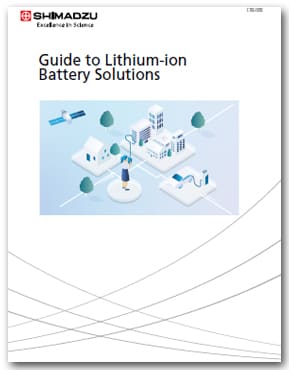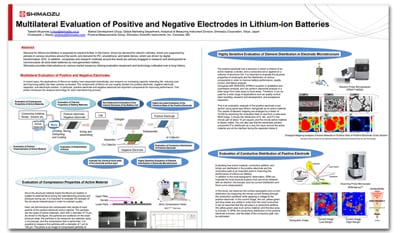Lithium-ion Batteries
Shimadzu Journal
Shimadzu Journal is an online technical publication. This issue focuses on lithium-ion batteries (LiB) which have attracted attention as we strive to make our society more sustainable. We introduce some of our customer's cutting-edge research, as well as applications and other topics related to our latest technology.
Lithium-ion Battery / All-Solid-State Battery
Demand for lithium-ion batteries is expected to expand further in the future, driven by demand for electric vehicles, which are supported by policies in various countries around the world, and demand for PC, smartphone, and tablet devices, which are driven by digital transformation (DX). In addition, companies and research institutes around the world are actively engaged in research and development to commercialize all-solid-state batteries as next-generation batteries.
On this page, we introduce the applications related to the positive electrode, negative electrode, separator, electrolyte, and battery cell.

The positive electrode is an important component that influences the performance of lithium-ion battery. Material development is underway to improve the high energy density and durability against charge/discharge cycles. In order to reduce the cost of battery and ensure a stable supply, the flow of cobalt-free positive electrode active materials is advancing.

As the market for lithium-ion battery for automotive use expands, the challenge is to further improve energy density while reducing costs. As a component, the negative electrode plays an important role together with the positive electrode.

Separator is an important component that prevents short circuits between positive and negative electrodes, and at the same time facilitates the smooth passage of lithium ions. In addition to high safety, high energy density, high input/output, and low cost are required, and performance evaluation from various viewpoints is important.

The electrolytes and solvents that make up the electrolyte solution must-have characteristics such as oxidation and reduction resistance during charge and discharge, thermal and chemical stability, and ionic conductivity, and must be capable of producing high-quality SEI coatings. It is also important to analyze electrolyte solution components in order to evaluate battery performance because the composition is modified by battery reaction.

Lithium-ion battery are used in a variety of fields and applications, and it is important to analyze defective products, compare good products and defective products, compare before and after charging and discharging, observe structural changes inside cells in cycle tests, and evaluate gas components.
Multilateral Evaluation of Positive and Negative Electrodes in Lithium-ion Batteries
Demand for lithium-ion Battery is expected to expand further in the future, driven by demand for electric vehicles, which are supported by policies in various countries around the world, and demand for PC, smartphone, and tablet device, which are driven by digital transformation (DX). In addition, companies and research institutes around the world are actively engaged in research and development to commercialize all-solid-state batteries as next-generation battery. Shimadzu provides total solutions to various market issues by utilizing evaluation equipment and technology cultivated over a long history.






